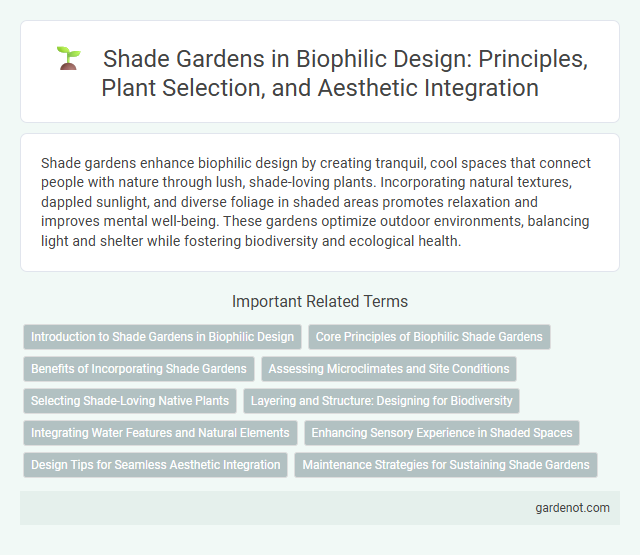Shade gardens enhance biophilic design by creating tranquil, cool spaces that connect people with nature through lush, shade-loving plants. Incorporating natural textures, dappled sunlight, and diverse foliage in shaded areas promotes relaxation and improves mental well-being. These gardens optimize outdoor environments, balancing light and shelter while fostering biodiversity and ecological health.
Introduction to Shade Gardens in Biophilic Design
Shade gardens play a crucial role in biophilic design by incorporating natural elements that provide cooling, shelter, and habitat diversity within shaded environments. These gardens typically feature shade-tolerant plants such as ferns, hostas, and woodland wildflowers that thrive under canopy cover while enhancing human connection to nature. Integrating shade gardens supports mental well-being and environmental sustainability by creating tranquil, shaded retreats that reduce urban heat island effects.
Core Principles of Biophilic Shade Gardens
Core principles of biophilic shade gardens emphasize the integration of natural elements like dappled sunlight, native shade-loving plants, and textured foliage to create a calming, restorative environment. Incorporating water features and natural materials such as wood and stone enhances sensory engagement and supports biodiversity. These gardens promote psychological well-being by establishing a harmonious connection between human spaces and shaded natural habitats.
Benefits of Incorporating Shade Gardens
Shade gardens enhance urban biodiversity by providing a cool, moist habitat for shade-loving plants and wildlife. These gardens reduce heat island effects and lower energy costs through natural cooling, improving overall environmental sustainability. Incorporating shade gardens also promotes mental well-being by creating tranquil, restorative green spaces that encourage relaxation and reduce stress.
Assessing Microclimates and Site Conditions
Assessing microclimates and site conditions in a shade garden involves analyzing sunlight patterns, soil moisture, and airflow to optimize plant selection and placement. Understanding the interplay between canopy cover and ground temperature helps create a balanced environment that supports diverse shade-tolerant species. Detailed evaluation of these factors enhances the biophilic design by fostering natural cooling, improving biodiversity, and increasing user comfort.
Selecting Shade-Loving Native Plants
Selecting shade-loving native plants is essential for creating a thriving shade garden that supports local biodiversity and requires minimal maintenance. Species such as ferns, hostas, and wild ginger are well-adapted to low-light conditions and provide natural habitat for native pollinators. Incorporating these plants enhances the biophilic design by fostering a seamless connection between indoor spaces and the natural environment.
Layering and Structure: Designing for Biodiversity
A shade garden utilizes layered planting to create multiple canopy levels, fostering diverse microhabitats that support various species. Incorporating structural elements such as textured bark, vines, and understory shrubs enhances habitat complexity and promotes local biodiversity. Thoughtful layering in shade gardens improves ecological resilience by providing shelter, food sources, and breeding sites for pollinators, birds, and beneficial insects.
Integrating Water Features and Natural Elements
Integrating water features such as ponds or cascading streams in a shade garden enhances the calming ambiance while supporting local biodiversity. Natural elements like ferns, mosses, and shaded woodlands create microhabitats that regulate temperature and humidity, promoting plant health. These components work synergistically to foster a tranquil, sensory-rich environment that embodies the principles of biophilic design.
Enhancing Sensory Experience in Shaded Spaces
Shade gardens in biophilic design enhance sensory experiences by incorporating diverse plant textures, colors, and fragrances that thrive in low-light conditions. The use of water features and natural materials like wood and stone amplifies tactile and auditory stimulation, creating a serene environment. Strategic layering of foliage maximizes dappled sunlight and cool microclimates, promoting relaxation and well-being.
Design Tips for Seamless Aesthetic Integration
Incorporate native shade-tolerant plants to enhance biodiversity and maintain ecological balance within a shade garden. Utilize natural materials such as wood and stone for pathways and seating to blend seamlessly with the green canopy and promote a calming environment. Integrate layered plantings with varied textures and heights to create depth and visual interest, ensuring a harmonious connection between the shaded areas and surrounding landscape.
Maintenance Strategies for Sustaining Shade Gardens
Effective maintenance strategies for shade gardens involve selecting shade-tolerant plant species that require minimal pruning and watering, ensuring sustainable growth with low resource input. Incorporating organic mulches helps retain soil moisture and suppress weeds, reducing the need for frequent intervention. Regular monitoring for pests and diseases allows early detection and control, preserving the health and longevity of the shade garden ecosystem.
Shade garden Infographic

 gardenot.com
gardenot.com